
Horse Evolution Over 55 Million Years
Excerpted from the Florida Museum of Natural History Fossil Horse Cybermuseum. http://www.flmnh.ufl.edu/natsci/vertpaleo/fhc/firstCM.htm
 |
This small dog-sized animal is the oldest found horse ancestor that lived about 55 million years ago. It had a primitive short face, with eye sockets in the middle and a short diastema (the space between the front teeth and the cheek teeth). Although it has low-crowned teeth, we see the beginnings of the characteristic horse-like ridges on the molars. |
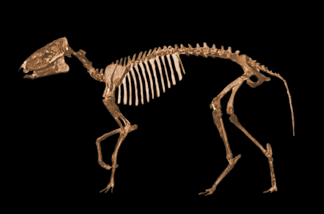 |
The earliest evidence of this “little horse” is found in the middle Eocene of Wyoming, about 2 million years after the first appearance of Hyracotherium. The two genera coexisted during the Eocene, although Orohippus fossils are not as numerous or as geographically widespread as those of Hyracotherium. Fossils of Orohippus have been found in Eocene sediments in Wyoming and Oregon, dating from about 52-45 million years ago. |
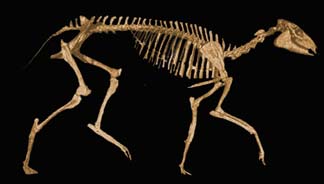 |
The "middle horse" earned its name. Mesohippus is intermediate between the eohippus-like horses of the Eocene, (which don't look much like our familiar "horse") and more "modern" horses. Fossils of Mesohippus are found at many Oligocene localities in Colorado and the Great Plains of the US (like Nebraska and the Dakotas) and Canada. This genus lived about 37-32 million years ago. |
 |
Species of Miohippus gave rise to the first burst of diversity in the horse family. Until Miohippus, there were few side branches, but the descendants of Miohippus were numerous and distinct. During the Miocene, over a dozen genera existed. Fossils of Miohippus are found at many Oligocene localities in the Great Plains, the western US and a few places in Florida. Species in this genus lived from about 32-25 million years ago. |
 |
Parahippus appears to be the evolutionary “link” between the old forest-dwelling horses and the modern plains-dwelling grazers. It has 3 toes, like primitive horses, but the side toes are smaller. They are "horse-faced," or long-headed with the eye socket well back from the middle of the skull. Fossils of Parahippus are found at many early Miocene localities in the Great Plains and Florida. Species in this genus lived from 24-17 million years ago. |
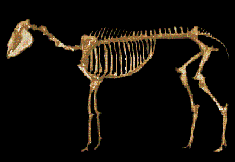 |
Merychippus represents a milestone in the evolution of horses. Though it retained the primitive character of 3 toes, it looked like a modern horse. Merychippus had a long face. Its long legs allowed it to escape from predators and migrate long distances to feed. It had high-crowned cheek teeth, making it the first known grazing horse and the ancestor of all later horse lineages. Fossils of Merychippus are found at many late Miocene localities throughout the United States. Species in this genus lived from 17-11 million years ago. |
 |
"Grandfather" to the modern horse, Pliohippus appears to be the source of the latest radiation in the horse family. It is believed to have given rise to Hippidion and Onohippidion, genera that thrived for a time in South American, and to Dinohippus which in turn led to Equus. Fossils of Pliohippus are found at many late Miocene localities in Colorado, the Great Plains of the US (Nebraska and the Dakotas) and Canada. Species in this genus lived from 12-6 million years ago. |
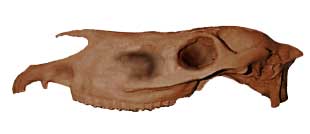 |
Dinohippus is believed to be the closest relative to Equus, the genus that includes the living horses, asses and zebras. Dinohippus fossils are found in the Upper Miocene of North America and date from 13 - 5 million years ago. |
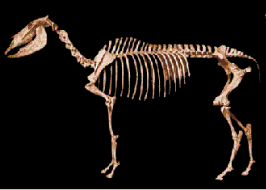 |
Equus is the only surviving genus in the once diverse family of horses. Domesticated about 3,000 years ago, the horse had a profound impact on human history in areas such as migration, farming, warfare, sport, communication, and travel. Species of Equus lived from 5 million years ago until the present. Living species include horses, asses, and zebras. Fossils of Equus are found on every continent except Australia and Antarctica. |
See detailed discussion of horse evolution at: http://www.talkorigins.org/faqs/horses.html
How can you explain the sequence of horse fossils? Even if you insist on ignoring the transitional fossils (many of which have been found), again, how can the unmistakable sequence of these fossils be explained? Did God create Hyracotherium, then kill off Hyracotherium and create some Hyracotherium-Orohippus intermediates, then kill off the intermediates and create Orohippus, then kill off Orohippus and create Epihippus, then allow Epihippus to "microevolve" into Duchesnehippus, then kill off Duchesnehippus and create Mesohippus, then create some Mesohippus-Miohippus intermediates, then create Miohippus, then kill off Mesohippus, etc.....each species coincidentally similar to the species that came just before and came just after?
Creationism utterly fails to explain the sequence of known horse fossils from the last 50 million years. That is, without invoking the "God Created Everything To Look Just Like Evolution Happened" Theory.
[And there is other evidence for evolution that is totally independent of the fossil record -- developmental biology, comparative DNA & protein studies, morphological analyses, biogeography, etc. The fossil record, horses included, is only a small part of the story.]
Creationists are thus forced into illogical, unjustified attacks of fossil dating methods, or irrelevant and usually flat-out wrong proclamations about a supposed "lack" of "transitional forms".
Don Lindsay - http://www.cs.colorado.edu/~lindsay/creation/fossil_groups.html
The question here is not "can we find a change from one species to another ". This page takes the discussion up one level, and looks for fossil connections between dozens or hundreds of species. Obviously, the time spans are longer. We might be talking about 10 million years instead of one million: or perhaps 30 million instead of 3 million.
The talk.origins Transitional Fossils FAQ lists a bunch of groupings - the bears, for instance. But there is a horse FAQ because we have such a huge collection of horse fossils, and because the pieces of the puzzle fit together so well.
Fifty five million years ago, there was an animal the size of a small dog, called Hyracotherium (sometimes incorrectly called Eohippus). Its front feet had four toes, and its back feet had three. Modern horse feet have a single hoof. So, are there transitional fossils that connect the two?
That suggests that the ancestors of the modern horse didn't have a hoof. So, do modern horses suggest any such ancestry?
That seems pretty clear. So, why have so many scientists been quoted as saying that something was wrong with the horse series?
They were actually complaining that the simple pictures are far too simple. It has in the past been shown as a "ladder of progress", a uniform and sure path from a starting point to an ending point. But in fact the horse family tree is enormous, and no one path through the tree is representative of all that went on. For example,
"Increase in size, for instance, did not occur at all during the first third of the whole history of the family. Then it occurred quite irregularly, at different rates and to different degrees in a number of different lines of descent. Even after a trend toward larger size had started it was reversed in several groups of horses which became smaller instead of larger."In fact, horse history was quite eventful, with four major migrations, and some mass extinctions. Also, the rate of evolution (measured in new species per million years) varied considerably. I don't have pictures of the transitional fossils - not because we don't have any, but because they are so numerous, and no one transition is the important one.Life of the Past, G.G. Simpson, Yale U. Press 1953. Page 125.
"All the morphological changes in the history of the Equidae can be accounted for by the neo-Darwinian theory of microevolution: genetic variation, natural selection, genetic drift, and speciation."Last modified: 19 October 2000Evolutionary Biology, D. J. Futuyma, Sinauer Associates 1986, p.409
Don Lindsay - http://www.cs.colorado.edu/~lindsay/creation/horse_tree.html
This diagram (from the horse FAQ) just shows genus names. In 1940, this diagram would have showed only 15 genera, representing only 200 species. But we just keep finding horse fossils. There are entire books about them.
The numbers down the left hand side are the dates. The present is at the top, and 55 million years ago is at the bottom.
2My Old & New World Equus
\ | /
\ | /
4My Hippidion Equus Stylohipparion
| | Neohipparion Hipparion Cormohipparion
| | Astrohippus | | |
| | Pliohippus ---------------------------
12My Dinohippus Calippus \ | /
| | Pseudhipparion \ | /
| | | |
------------------------------------------- Sinohippus
15My \ | / |
\ | / Megahippus |
17My Merychippus | |
| Anchitherium Hypohippus
| | |
23My Parahippus Anchitherium Archeohippus
| | |
(Kalobatippus?)-----------------------------------------
25My \ | /
\ | /
|
35My |
Miohippus Mesohippus
| |
40My Mesohippus
|
|
|
45My Paleotherium |
| Epihippus
| |
Propalaeotherium | Haplohippus
| | |
50My Pachynolophus | Orohippus
| | |
| | |
------------------------------
\ | /
\ | /
55My Hyracotherium
Last modified: 10 January 1998